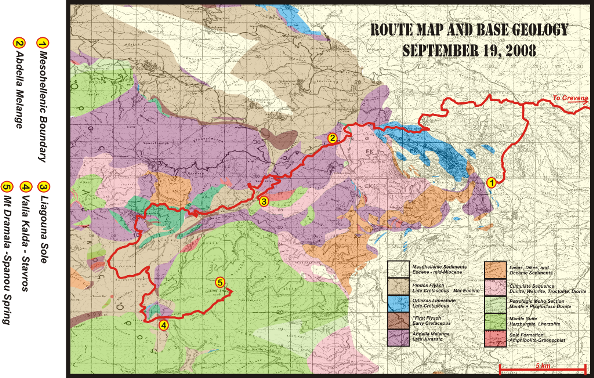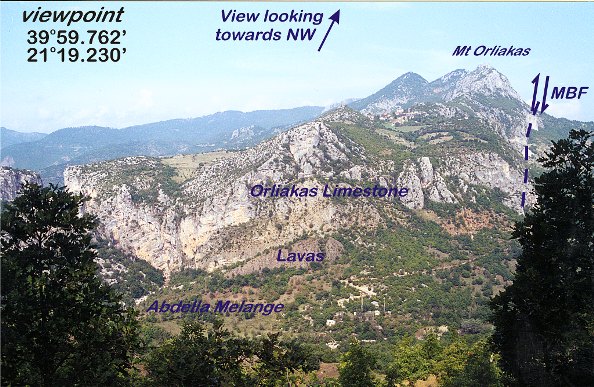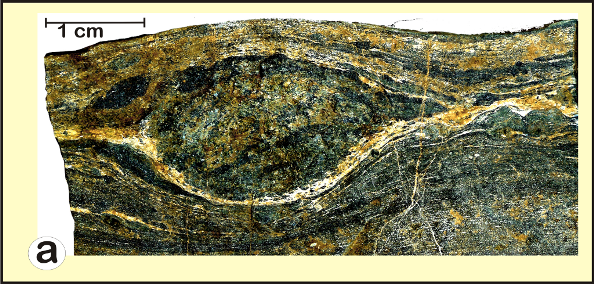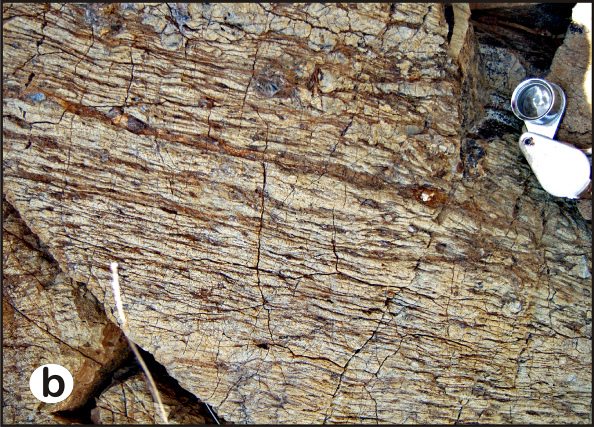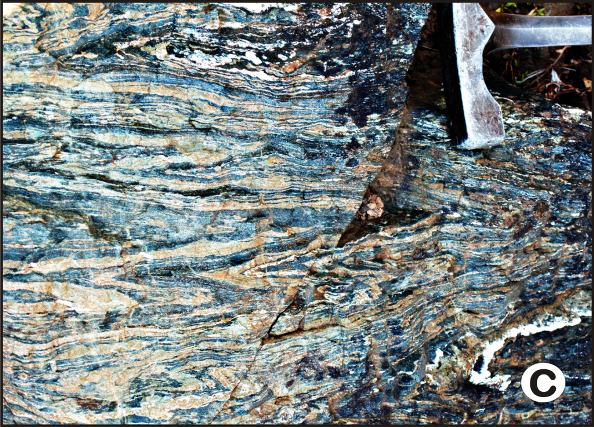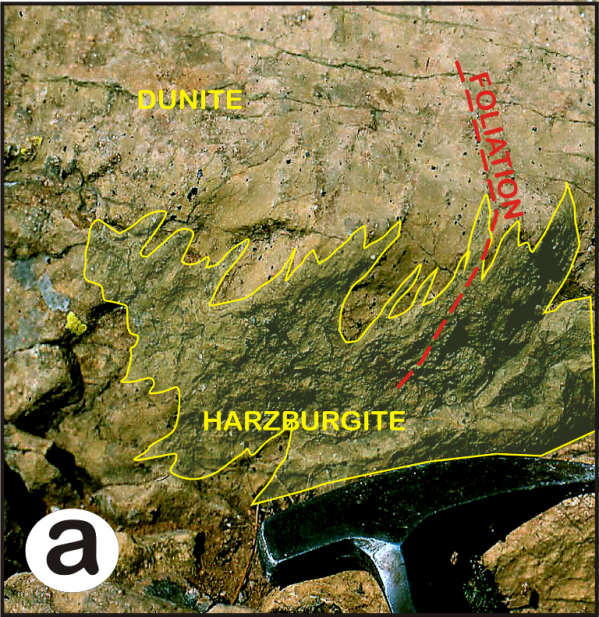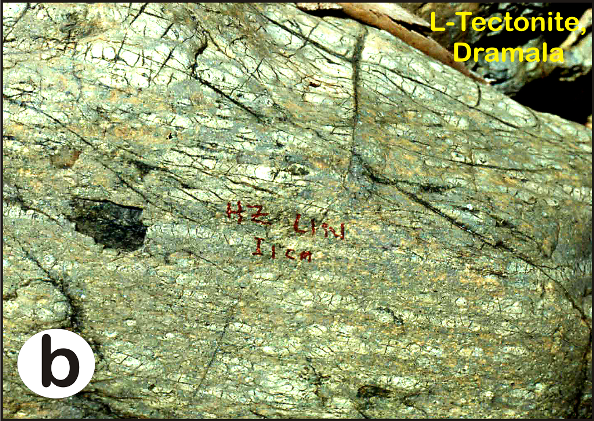Day 5 -THE PINDOS NAPPE OPHIOLITE
Ophiolites of the high Pindos are parts of a >2000km2 nappe complex emplaced over Eocene flysch: this emplacement is entirely brittle field, and its imprint is imposed on all pre-emplacement lithologies of the region. These SW-topping structures at places appear constrictive, in particular among the nappes themselves, while along the major contact of the nappe complex over the flysch, nappe-parallel brittle foliation appears to have formed at least in part from gravity sliding.
The precise geographic origin of the nappe complex is indeterminate: ophiolitic nappe margins in apparent continuation to ophiolitic units rooted in the Mesohellenic Trough (MHT) are obscured by deformation related to the origin and evolution of the MHT. The interior of the nappe complex retains a coherent strato-tectonic assemblage, giving the impression that the complex itself was not displaced any great distance. The orientations of ductile and ductile-brittle structures within the ophiolite parallel those of Vourinos and approximate those of the W Othris peridotite massifs: thus, displacements between these ophiolites apparently did not impose rotation. The sense of topping directions within the nappe, defined by ductile to ductile-brittle structures and brittle-emplacement ramps, show NE motion consistent in style to that of a large thrust sheet, that is, NE displacement facilitated by NE-striking lateral tear imbricates. Ramp stacking occurs along the eastern margin, and is largely responsible for the “inverted” ophiolite stratigraphy. Individual ramps overlap petrologically, thus breakage and shortening of the section appears less severe than for the disassociated Othris-Koziakas nappes: the mantle-cumulate Dramala imbricate overrides the cumulate-sheeted dike Ambelia imbricate, which in turn overrides a dike-pillow section.
The high-temperature ophiolitic sole is intact at several localities. Banded amphibolite with rare garnet occurs between the basal ophiolitic rocks and the Avdella Mélange, a block-and-matrix accretionary complex. At the Liagouna locality, the amphibolite is about 100m thick, and emplacement metamorphism extends into the mélange for several hundred meters as a transition of amphibolite-greenschist-zeoloite facies. Amphibolite sole also occurs along the base of nappes of higher ophiolite units, such as the “near-moho” harzburgite and plagioclase dunites of Vasilitsa, gabbro cumulates of Orliakas, and as greenschist-facies banded sole rocks underlying lava units of the Monahiti area. Amphibolite dating of the sole constrains the emplacement age to between 169±5 and 165±3 Ma, while zircon dating of plagiogranite gives a crystallization age of 171±4my. The Eocene SW-topping back-thrust of the Pindos nappe ophiolite included the ophiolitic sequence itself, its immediate sole and host formations to obduction (Avdella Mélange), as well as the lower Cretaceous “first flysch” and upper Cretaceous limestone.
The glaciated mantle peridotite of the nappe complex allows spectacular viewing of mantle structure and melt phenomena. The continuity of deformation from ductile to brittle field , and the consistency of orientation of these structures within a NE obducting slab model, implies that these peridotites preserve the deformation mechanisms active during slab detachment and initial emplacement motions.
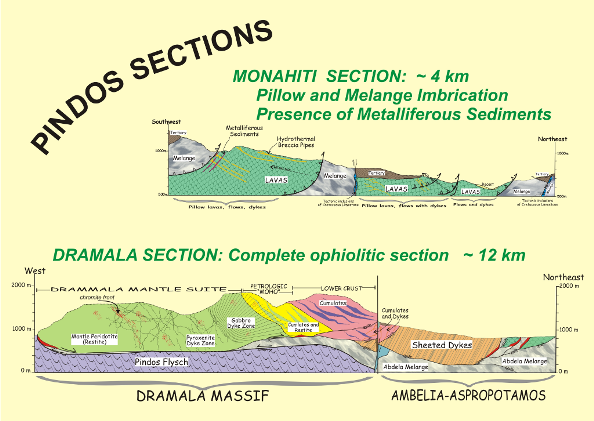
Cross sections through the Pindos nappe ophiolite. Upper section: imbricated pillow lava, dike, and Avdella mélange units at Monohiti. Lower section: composite section through entire ophiolitic nappe. The Dramala massif includes an coherent mantle – crustal cumulate section, over-riding imbricates of crustal cumulate units to lavas.
Cumulate rocks occur in continuous section with mantle rocks on Dramala, their transition comprising a “petrologic Moho.” Cumulates are also in continuous section with plagiogranites and sheeted dikes in the Ambelia imbricate. Lowermost cumulates are pods of plagioclase dunite within harzburgite in the Moho section, with gradual reduction of harzburgite upward, then as series of thin, lensing layers of dunite-wehrlite-troctolite (sills?) within the ultramafic cumulate section. Mafic cumulates above this consist of gabbro and troctolite, grading upsection to diorite and plagiogranite.
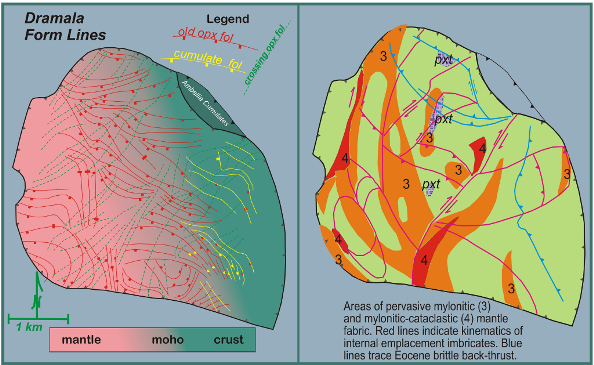
Left figure: Macrofabric map and position of “petrologic moho” over the Dramala massif. Right figure: Zones of mylonitic fabrics hosted by higher temperature mantle fabrics within the Dramala massif.
The Pindos nappe includes a thick imbricate including sheeted dikes, massive flows, and pillow lavas that straddle greenschist to zeolite metamorphic facies. Oceanic sediments are present within pillow lavas as interstitial material and isolated layers, but the ocean layer one interface (sediments over pillow lavas) accomodated thrust movement and is rarely intact.
In a geochemical sense, ophiolitic lithologies comprise two sequences of contrasting petrology and geochemical evolution, termed the Eastern Aspropotamos Complex and the Western Aspropotamos Complex. The Eastern Aspropotamos Complex is a 2-km thick polygenetic assemblage of diverse oceanic magma types. Its lowermost cumulate sequence consists of minor dunite–wehrlite–lherzolite layered intervals crystallized from a boninitic magma. These are overlain, but not intruded, by few dunite–troctolite–anorthosite–gabbro cyclic units, the latter exhibiting flaser structures, which, together with the overlying sheeted dikes and associated pillow lavas have crystallized from a Ti-rich normal mid-ocean ridge basalt (N-MORB) magma. Rare dikes, belonging to a Ti-poor N-MORB magma cut across the latter and feed overlying sparse pillow lavas. Both N-MORB units are, in turn, cut by dikes of transitional N-MORB/island-arc tholeiite (IAT) and primitive IAT character, the latter possibly parental to a seamount of differentiated IAT lavas built atop the pre-existing N-MORB crust. N-MORB and IAT lithologies are intersected by scarce dikes possessing a chemistry transitional between IAT and boninites (BSV). These, in turn, are cut by boninitic dikes proper, consanguineous with the lowermost ultramafic layered series of the complex. By contrast, the Western Aspropotamos Complex shows a much simpler volcanic stratigraphy, organized in two major magmatic episodes. The earlier episode is represented by lavas and dikes of IAT/BSV transitional chemistry, whereas the later episode is clearly of boninitic affinity. The thick plutonic and genetically related volcanic sections in the Western Aspropotamos Complex imply considerable melt storage before eruption.
Petrogenetic modelling indicates that at least three different sources are required to generate the Eastern Aspropotamos Complex units, whereas two different sources are required to generate the Western Aspropotamos Complex units at realistic degrees of mantle partial melting. These sources differ primarily in their clinopyroxene content, the latter being >8%, >6% and <7 wt.% for the MORB+MORB/IAT, IAT+IAT/BSV and BSV units respectively. All units appear to have been generated under 'open'-system conditions, characterized by very few replenishment cycles, low fractionation/eruption rates and low input rates. Moreover, the supra-subduction zone units show variable additions of rare-earth and high-field strength elements that can be explained by dynamic melting processes operating on source regions contaminated by oceanic island basalt-like and subducted oceanic sediment-derived melts. Field, geochemical and petrogenetic data support the interpretation that the Eastern Aspropotamos Complex was possibly formed near a trench-transform-ridge triple junction position similar to the southern termination of the Marianas Trench, whereas the Western Aspropotamos Complex was formed within the subduction fore-arc.
Stop 1. Pindos Ophiolite - Mesohellenic Boundary
The fieldtrip route crosses the Mesohellenic trough between Vourinos and the Pindos: magnetic and gravity maps confirm ophiolitic basement to a depth of at least 25 km as a keel-shaped structure. Mesohellenic sediments, including molasse and flysch, of late Eocene to mid-Miocene age fill the trough to near 5000 m thickness. Gentle west-dipping sediments towards Vourinos turn to east-dipping towards the Pindos and in the vicinity of NW-striking, Tertiary constrictional faults. Descending from the Mavronei Junction, the local Mesohellenic sediments include minor reverse faults and syn-sedimentary gravity faults.
The Mesohellenic Boundary Fault (MBF) is exposed along the extremely steep NE face of Mt Orliakas. The fault extends from this site to the NW into Albania and to the SE into the Koziakas area, a distance of 150 km. Our viewpoint of the MBF from Parorio exposes the fault of the Orliakas limestone (late Cretaceous, rudistid bearing) over a footwall including the Avdella melange and associated lava imbricates. The limestone is tectonically included as competent blocks within complex deformation zones hosted by less competent melange, flysch and serpentinite. Cretaceous blocks range in size from Orliakas itself, down to slender but prominent ribs on the scale of tens of meters. On the Portitsa side of the valley within the view, the limestone appears to be emplaced onto Tertiary Mesohellenic sediments.
Formation of the Mesohellenic trough was accompanied by steep fault sets parallel and perpendicular to the boundary fault that rotate ophiolitic terrane in the position of tectonic corridors.
Stop 2. Pindos Ophiolite - Avdella Melange
The Avdella Mélange is a block and matrix accretionary sedimentary mélange that comprises the footwall formation to the Pindos ophiolite. In contrast to the Ayios Nikolas formation of Vourinos, it lacks Pelagonian continental fragments and the matrix is characteristically non-metamorphosed away from the sole. Blocks include Tr- to upper Jr-aged ribbon cherts, limestones, pillow lavas, and serpentinites.Their sizes range in scale from hand-sample to several km2. The matrix is well-exposed and consists of mudstones and siltstones sometimes grading to chert, and hyaloclastic detritus. Blocks frequently show deformation that is not penetrative into the matrix in contrast to the Ayios Nikolas formation of Vourinos. Internal deformation in the matrix varies from weak schistosity to complex ramp structures. The Avdella Mélange south of Kranea includes fragments of sole amphibolite, and also appears to include a lower temperature sole along internal emplacement zones. The mélange is tectonically emplaced over early Cretaceous “first flysch” carbonates, and these in turn over the Cretaceous to Eocene Pindos Flysch. Younger Cretaceous limestones (Orliakas Group) crop out as tectonically included fragments of competent material within flysch, mélange, and serpentine dominated complex deformation zones.
Stop 3. Pindos Ophiolite - Liagouna Sole
The Liagouna Sole at: 39°58.965’ 21°10.591’
On Liagouna, the garnet-bearing amphibolite sole formation exceeds 100m thickness. Serpentinized harzburgites above the sole display primary mylonitic fabric with elongate orthopyroxenes. Metamorphism within and beneath the sole is gradational, extending several hundreds of meters into the Abdella Melange, decreasing through greenschist and zeolite facies. Sole amphibolite is banded, grey-white to black, with augen structures and complex folds. Garnet has been located at the sole contact itself within a δ structure.
The contact zone here is near vertical, rotated most likely during ductile-phase emplacement. Brittle structures crosscutting the sole zone, ramps and minor imbricates, show constrictional topping directions to the NE.
Stop 4. Pindos Ophiolite - Valia Kalda
VALIA KALDA – STAVROS

Panorama: Valia Kalda – View from Stavros locality. All visible terrane and mountain peaks are mantle peridotite.
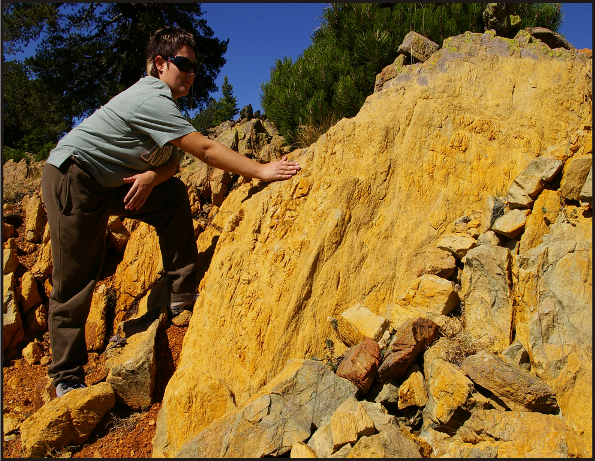
Unaltered mantle harzburgite showing traces of ductile ramping structures showing topping to east.
Valia Kalda is a tectonic window through the peridotite nappe of the Pindos ophiolite (high peaks) exposing Pindos flysch and Cretaceous imbricates (valley floor). Other ophiolitic members and Abdella Melange are tectonically thinned out from here and to the SW.
At Stavro, the peridotite is fresh: loss on ignition is lacking, and indeed, small positive gains on ignition are characteristic. This harzburgite/lherzolite is moderately strained, but not very mylonitic, demonstrating higher temperature intragranular deformation processes. Foliation of the tectonite dips SW, and defines a symmetrical imbricate-shaped fold on the scale of several hundred m2 topping NE. Imprinting this are ~30o S-plunging lineations, ductile ramp structures (photo to right) topping to the NE, and younger brittle shears.
Several hundred meters up the road from Stavros towards the top of Dramala (Spanou Spring area), L-tectonite peridotite crops out.
Stop 5. Pindos Ophiolite - Mt Dramala
MT DRAMALA – SPANOU SPRING
Several of the ductile structures observed on Mount Dramala at or near: 39°56.489’ / 21°09.816’
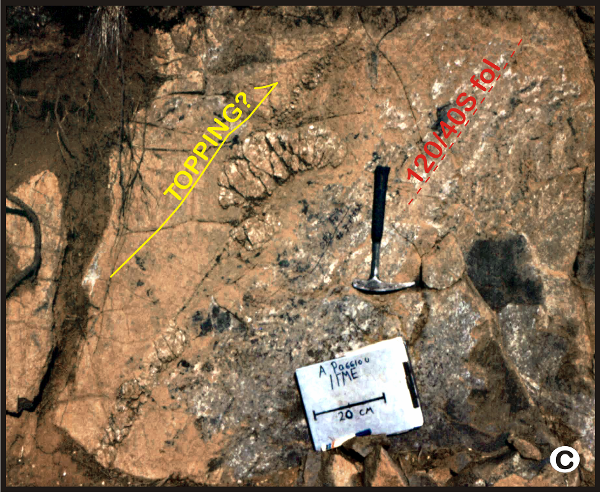
Pyroxenite boudin deformed along foliation / layering surface in mantle peridotite.
From Valia Kalda, the road ascends to the glaciated top of Dramala with a stop at the Spanou Spring site. Here, the harzburgite shows evidence of ductile kinematics synchronous to probable remelting in a hydrous environment allowing for intrusion of pyroxenite pegmatite dykes. Pyroxenites occur as irregular blebs and as meter-scale “boudins” deformed to δ-shapes by pervasive, continual kinematics. By comparison, ductile deformation of pyroxenite dikes at Vourinos is limited to several occurrences where the dikes are entrapped in emplacement-related mylonite zones.
Chrome spinel morphologies show deformation foliations and lineations within harzburgite and dunite, but individual grains are euhedral near and within pyroxenites, implying metasomatic growth.
Nearby, a single chromitite layer has been discovered that is ~10cm thick, traceable in outcrop for about 200 m, with probable continuations for over a 2 km distance. Ductile tectonic thinning is presumably responsible for this morphology.
Consider: The appearance of the peridotite suggests multiple phases of melting.
